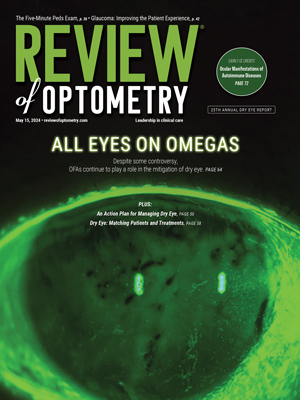Because this subject is so fraught with emotional issues for both doctor and patient, our natural tendency is to avoid dealing with the problem directly.

Many conditions can result in a blind, painful eye, including end stage glaucoma, neovascular glaucoma, chronic retinal detachment, trauma, and postoperative complications such as endophthalmitis and failed corneal grafts. Most of these conditions develop slowly with gradual vision loss and increasing pain. Your initial management should aim to reduce pain and make the patient physically and emotionally comfortable.
Looking Good
Your secondary goal is to achieve a level of cosmetic appearance that is acceptable to the patient. First, make sure the patient has no visual acuity in the eye (that is, no light perception). Also, be sure that there is no reasonable chance that the vision can be improved by any means. If the patient meets both of these criteria, and the eye is cosmetically acceptable to him or her, medical treatment should be your first option.
Start the patient on Pred Forte (prednisolone acetate 1%) qid and Atropine 1% bid. A chronic breakdown of the corneal epithelium due to increased intraocular pressure causes many cases of pain in a blind eye. Additional medications are often necessary to reduce the IOP and provide the patient with relief in these cases. The pain can generally be controlled for years on this regimen, although it does put patients at increased risk for developing ocular surface infections.
Feeling Good
When medical treatment fails to control the pain and the eye is cosmetically acceptable to the patient, many other management
options are available. Retrobulbar alcohol injections have been used to control the pain in blind eyes since the early 1900s.1 Pain control was achieved in up to 87% of patients who received the injections for a period of three months, although other studies have reported lower rates of success.

This macrophotograph of an enucleated eye shows most of the retina in the calotte is thickened and opacified by diffuse, infiltrating retinoblastoma. The tumor covers the pars plana and has seeded the angle.
Repeated injections are necessary for long-term pain management. As an alternative to alcohol, retrobulbar injection with chlorpromazine has been reported to be very successful at achieving long-term pain management in blind eyes. A single retrobulbar injection of chlorpromazine provided 80% of blind eyes pain relief for more than one year in duration.2 In addition to retrobulbar injections, both cyclocryo-therapy and cyclophotcoagulation can help control refractory glaucoma and relieve chronic pain. However, both of these techniques carry a significant risk of phthisis.
Last Resort
The ultimate treatment for the blind, painful eye is enucleation. Researchers in St. Louis, Mo., achieved complete symptomatic pain relief in 93% of blind patients after enucleation.3 Consider this only when the eye is cosmetically compromised or when medical treatment of the pain has been unsuccessful.
Modern techniques of enucleation and reconstruction with prosthesis can result in excellent cosmetic outcomes. Many patients are psychologically hesitant to entertain the possibility of enucleation. However, we should not hesitate to broach this uncomfortable topic with patients because enucleation has the highest chance of eliminating the pain and putting an end to what is often a long and arduous process of trying to save the eye and the patients vision.
1. Olurin O, Osuntokun O. Complications for retrobulbar alcohol injections. Ann Ophthalmol 1978:10;474-476.
2. Chen TC, Yuen SJA, Sangaland MA, et al. Retrobulbar chlorpromazine injections for the management of blind and seeing painful eyes. J Glaucoma 2002;11:209-213.
3. Custer PL, Reistad CE. Enucleation of blind, painful eyes. Ophthal Plast Reconstr Surg 2000 Sept.;16(5):326-9.

